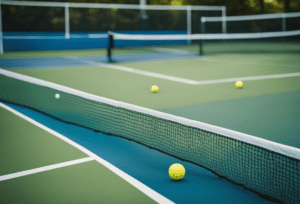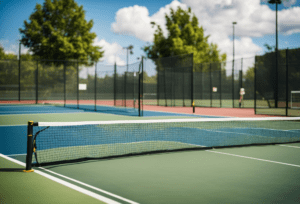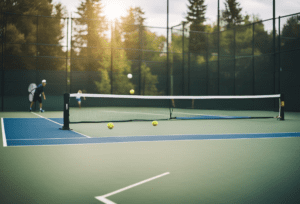Are you curious about the differences between pickleball and tennis? While both sports involve hitting a ball over a net, there are several key differences that set them apart. One of the most significant differences is the size of the court. Tennis courts are much larger, measuring 78 feet in length and 36 feet in width, while pickleball courts are only 44 feet in length and 20 feet in width.

Another major difference between pickleball and tennis is the equipment used. Tennis players use racquets to hit a soft, felt-covered ball, while pickleball players use paddles to hit a lightweight, plastic ball with holes. Additionally, the serving rules are different between the two sports. In tennis, players serve from behind the baseline, while in pickleball, players serve from behind the baseline but must hit the ball underhand and keep their feet behind the back line until the ball is struck.
Whether you’re a seasoned athlete or a beginner, understanding the differences between pickleball and tennis can help you choose which sport is right for you. Keep reading to learn more about the unique characteristics of each sport and how they compare to one another.
Origins of Pickleball and Tennis
Pickleball and tennis are both racquet sports, but they have different origins and histories.
Tennis
Tennis has a long and rich history that dates back to 12th century France. It was originally played with the palm of the hand, but over time, players began to use gloves and then racquets. The game was called “jeu de paume” (game of the palm) until the 16th century when it became known as tennis. Today, tennis is played all over the world and is one of the most popular sports.
Pickleball
Pickleball, on the other hand, is a relatively new sport that was invented in 1965 by Joel Pritchard, Bill Bell, and Barney McCallum. The three friends were looking for a game to play with their families, and they ended up creating a new sport by combining elements of tennis, badminton, and ping-pong. They named the game “pickleball” after their dog, Pickles, who would chase after the ball and run off with it.
Pickleball quickly became popular, especially among older adults who found it to be a less strenuous alternative to tennis. Today, pickleball is played all over the world and is growing in popularity among people of all ages.
In summary, tennis has a long and storied history that dates back centuries, while pickleball is a relatively new sport that was invented in the 1960s. Despite their different origins, both sports are enjoyed by millions of people around the world and offer many health benefits.
Playing Court Differences

When it comes to the playing courts, there are several differences between pickleball and tennis. Let’s take a closer look at each sport’s playing court.
Pickleball Court
A pickleball court is a rectangular area that measures 20 feet wide and 44 feet long. The court is divided into two equal halves by a net that is 36 inches high at the ends and 34 inches high at the center. The court also has a non-volley zone, also known as the kitchen, which is a 7-foot area on both sides of the net.
Tennis Court
A tennis court is also a rectangular area, but it is larger than a pickleball court. A tennis court measures 78 feet long and 27 feet wide for singles matches, and 78 feet long and 36 feet wide for doubles matches. The net is 3 feet high at the center and 3.5 feet high at the posts.
Key Differences
The main difference between the two courts is their size. A pickleball court is only one-third the size of a tennis court. This smaller size makes pickleball a more accessible sport for people of all ages and skill levels. Additionally, the non-volley zone in pickleball adds an extra layer of strategy to the game, as players must be careful not to step into this area while hitting the ball.
Another difference is the surface of the court. Tennis courts can be made of various materials, including clay, grass, and hard court surfaces. Pickleball courts are typically made of concrete or asphalt, although there are some indoor courts made of wood.
Overall, the differences in playing court size and surface make pickleball and tennis unique sports, each with their own set of challenges and strategies.
Equipment Used
One of the most significant differences between pickleball and tennis is the equipment used. In pickleball, players use a solid paddle made of materials like wood, composite, or graphite. These paddles are wider than tennis rackets and have a flat, square-shaped hitting surface. The paddles are typically between 15.5 and 17 inches long and 7.5 to 8.25 inches wide. The grip of the paddle is similar to a tennis racket, but the shape is more rectangular.
On the other hand, tennis players use string rackets and soft balls. Tennis rackets are typically made of graphite, aluminum, or a composite material. The strings are tightly strung to provide a large hitting surface. Tennis balls are made of rubber and covered with felt. They are larger and heavier than pickleballs.
Another difference in equipment is the ball used. Pickleballs are hollow plastic Wiffle™-like balls. They are smaller than tennis balls, measuring 2.87 inches in diameter and weighing between 0.78 and 0.935 ounces. Tennis balls measure 2.7 inches in diameter and weigh between 1.975 and 2.095 ounces.
In terms of clothing, both sports require comfortable athletic wear. Tennis players typically wear shorts, skirts, or dresses, and a collared shirt. Pickleball players can wear anything from shorts and a t-shirt to athletic wear. Both sports require appropriate footwear, such as tennis shoes or court shoes, to provide the necessary support and grip on the court.
Overall, the equipment used in both sports is unique and tailored to the specific needs of each game. Whether you prefer the solid paddle and plastic ball of pickleball or the string racket and soft ball of tennis, both sports offer a fun and challenging experience for players of all skill levels.
Scoring System
In tennis, the scoring system is more complex than in pickleball. A standard tennis game is played to four points, which are referred to as 15, 30, 40, and game. If both players reach 40, it is called deuce, and the player who wins the next point gets the advantage. If the player with the advantage wins the next point, they win the game. If they lose the point, the score goes back to deuce. The first player to win six games wins the set, and the first player to win two or three sets wins the match.
In pickleball, the scoring system is simpler. Games are played to 11 points, and players can only score if they served. If the score is tied at 10-10, the game continues until one player has a two-point lead. If the score reaches 14-14, the first player to score the next point wins the game. The first player to win two out of three games wins the match.
In tennis, there are also tiebreakers if the score in a set reaches 6-6. The first player to win seven points with a two-point lead wins the tiebreaker and the set. In pickleball, there are no tiebreakers, and the game continues until one player wins by two points.
Overall, the scoring system in tennis is more complex, while the scoring system in pickleball is simpler and easier to understand. Whether you prefer the challenge of a more complex scoring system or the simplicity of a straightforward one, both sports offer unique and exciting gameplay.
Rules and Regulations

Pickleball and tennis have different rules and regulations that players need to follow. Here are some of the key differences:
Court Size
Pickleball courts are smaller than tennis courts. A pickleball court is 20 feet wide and 44 feet long, while a tennis court is 27 feet wide and 78 feet long. This means that pickleball players have less ground to cover and can move around the court more quickly.
Scoring
In tennis, matches are typically played using a best-of-three or best-of-five sets format. Each set consists of games, and each game is scored using a system of points (love, 15, 30, 40, game). A player must win six games to win a set, and must win two out of three or three out of five sets to win the match.
In pickleball, matches are usually played using a best-of-three games format. Each game is scored using a system of points (0, 1, 2, 3, 4, 5, 6, 7, 8, 9, 10, 11). A player must win 11 points and be leading by at least two points to win a game, and must win two out of three games to win the match.
Serving
In tennis, players must serve from behind the baseline and alternate serving between points. The serve must be made diagonally across the net and into the opponent’s service box. If the serve is not successful, the player gets a second chance. If the second serve is also not successful, the player loses the point.
In pickleball, players must serve from behind the baseline and serve diagonally across the court. The serve must land in the opponent’s service box, and the server must keep at least one foot behind the baseline until the ball is struck. If the serve is not successful, the player gets a second chance. If the second serve is also not successful, the opponent gets the point.
Faults
In tennis, a fault occurs when the serve does not land in the opponent’s service box, the server steps on or over the baseline before hitting the serve, or the server misses the ball completely.
In pickleball, a fault occurs when the serve does not land in the opponent’s service box, the server steps on or over the baseline before hitting the serve, the ball hits the net and does not land in the opponent’s service box, or the ball is hit out of bounds.
Overall, while both sports have similarities in terms of equipment and technique, they have distinct differences in terms of court size, scoring, serving, and faults.
Player Skills Required
While both pickleball and tennis require similar physical skills such as hand-eye coordination, agility, and endurance, there are some differences in the specific skills required for each sport.
Pickleball Player Skills
To be a successful pickleball player, you need to have quick reflexes and be able to move laterally and forward and backward with ease. You also need to have good control over the paddle and be able to hit the ball with precision.
In addition, pickleball requires players to have a good understanding of the rules and strategies of the game. For example, players need to know when to hit the ball softly or with more power, when to play defensively or offensively, and when to stay back or move forward to the net.
Tennis Player Skills
Tennis players, on the other hand, need to have more upper body strength and be able to hit the ball with more power. They also need to have good footwork and be able to move quickly around the court.
Tennis players need to have a good understanding of the different shots they can use, such as the forehand, backhand, and serve. They also need to be able to read their opponent’s shots and adjust their own strategy accordingly.
Overall, while both sports require similar physical skills, there are some differences in the specific skills required for each sport. Whether you choose to play pickleball or tennis, it’s important to practice regularly and work on improving your skills to become a better player.
Popularity and Global Reach
Both pickleball and tennis are popular racquet sports, but they differ in terms of global reach and popularity. Tennis is a well-established sport with a long history of professional circuits, major tournaments, and millions of fans worldwide. In contrast, pickleball is a relatively new sport that is gaining popularity rapidly due to its accessibility and social appeal.
Tennis is played at both amateur and professional levels worldwide, and it has a strong following in countries such as the United States, Spain, France, and Australia. The sport has four major tournaments known as the Grand Slam events, which are held annually in different countries. These events attract the best players from around the world, and they are watched by millions of fans on television and online.
Pickleball, on the other hand, is a sport that is still in its infancy. It was invented in the United States in the 1960s and has since gained popularity in countries such as Canada, the United Kingdom, and Australia. While pickleball isn’t yet on par with tennis regarding global influence and pro tournaments, its charm is increasingly catching on, spurred by its user-friendliness and the social buzz it generates.
One reason for pickleball’s popularity is that it is easy to learn and play. The sport uses a smaller court and a lower net than tennis, which makes it less physically demanding and easier on the joints. This makes it a great option for people of all ages and fitness levels, including seniors and those with disabilities.
Another reason for pickleball’s popularity is its social appeal. The sport is often played in doubles, which makes it a great way to meet new people and make friends. Pickleball also has a fun and friendly atmosphere, which makes it a great option for those who want to enjoy a sport without the pressure of competition.
Overall, while tennis may have a more established global following and professional circuits, pickleball’s accessibility and social appeal are making it a popular choice for people of all ages and backgrounds.
Health Benefits
Both pickleball and tennis offer significant physical and mental health benefits, according to a study conducted by Apple. The study analyzed heart rate data from the Apple Watch and found that tennis resulted in a higher peak heart rate compared to pickleball. However, pickleball still provided a great cardiovascular workout, with an average peak heart rate of 143 beats per minute.
In addition to cardiovascular benefits, both sports offer a full-body workout that can improve strength, flexibility, and coordination. The quick movements required in both sports can also help improve agility and reaction time.
One unique benefit of pickleball is that it is a low-impact sport, making it a great option for people with joint pain or injuries. The smaller court size and slower ball speed also make it a more accessible sport for beginners or older adults.
In terms of mental health benefits, both sports can provide stress relief and improve mood. Participants in the study often reported feeling more energized and less stressed after playing either sport. Interestingly, pickleball players ranked lower than tennis players on the mental health scale, meaning they are less likely to experience mental health issues.
Overall, both pickleball and tennis offer significant health benefits and can be a fun way to stay active and improve overall well-being.
Conclusion
In conclusion, while tennis and pickleball share some similarities, they are two distinct sports with different rules, equipment, and playing styles. Tennis is a more physically demanding sport that requires a lot of power, speed, and endurance, while pickleball is a more strategic and less physically demanding sport that relies more on finesse and skill.
One of the key differences between the two sports is the equipment used. Tennis players use larger rackets and heavier balls, while pickleball players use smaller paddles and lighter plastic balls with holes. The court sizes are also different, with tennis courts being larger than pickleball courts.
Another important difference is the serving styles. Tennis players use an overhand serve, while pickleball players use an underhand serve. Pickleball serves must be made diagonally to the opposite side of the court, while tennis serves can be made anywhere within the service box.
The scoring system is also different between the two sports. In tennis, players must win four points to win a game, while in pickleball, players must win 11 points to win a game. Tennis matches can last for several hours, while pickleball matches typically last for 30 minutes to an hour.
Overall, whether you prefer the fast-paced action of tennis or the more relaxed and social atmosphere of pickleball, both sports offer a great way to stay active and have fun. So why not try both and see which one you like best?

